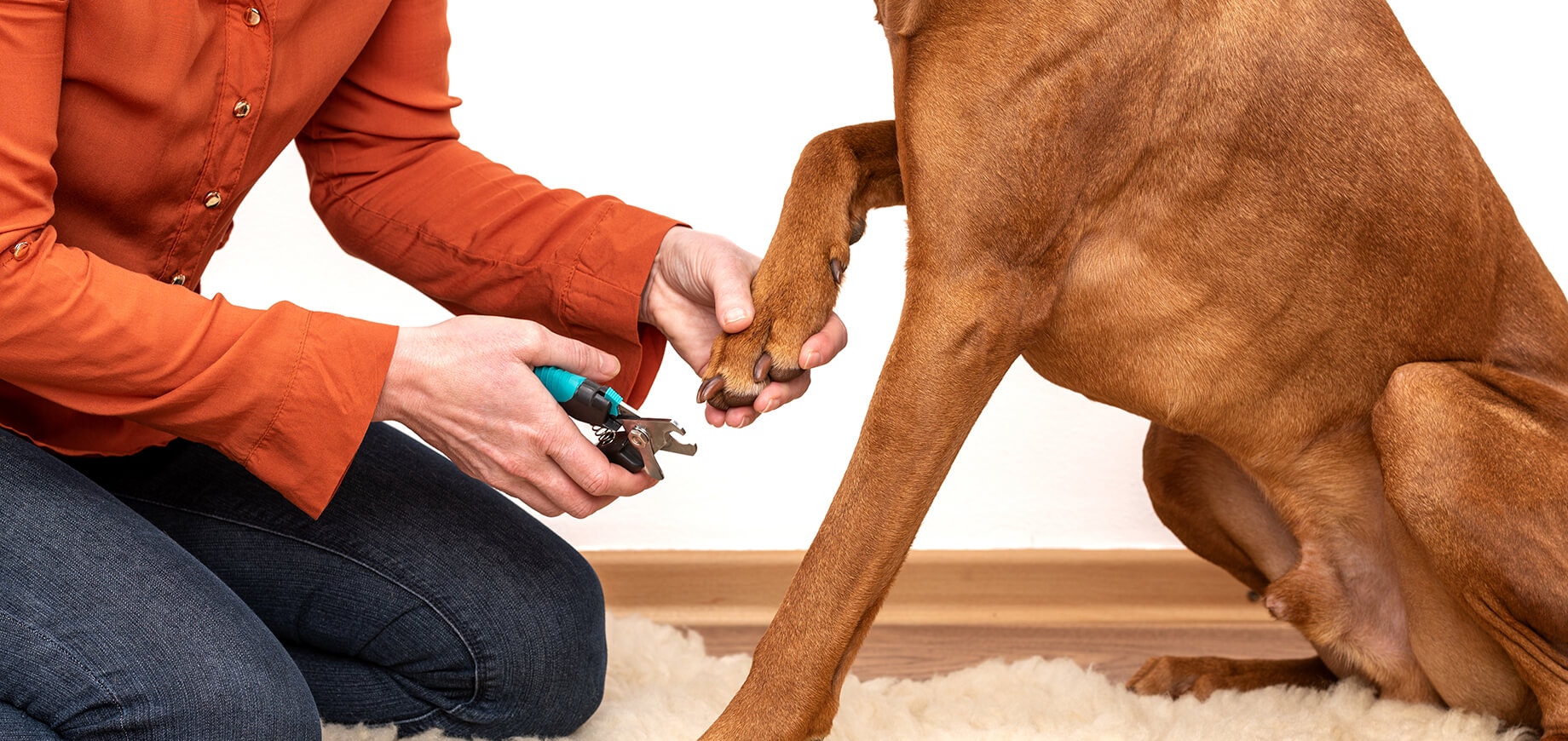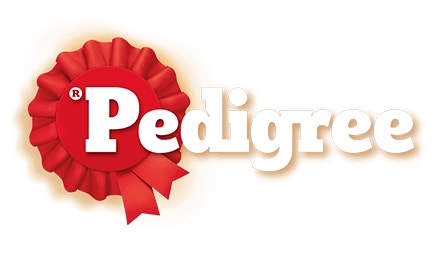

If you can hear your dog’s claws clattering on hard floors, it’s a telltale sign that it’s time for a trim! But if you're a new pet parent, the thought of cutting dogs’ nails might make you a bit nervous. We’re here to help by talking you through how to cut dog nails at home.
Overgrown nails make it uncomfortable for your dog to walk and run. The long talons can even painfully dig into tender paw pads, which is why keeping your dog's nails neatly trimmed helps to prevent potential issues. This article looks at how long should dog nails be, and how to cut your dog’s nails safely and swiftly whilst keeping your dog comfortable.
Dog nail clipping is part of an important care routine for all pups. Overly long nails make normal activities like running and walking painful because they can hurt their paw pads. Untrimmed nails can painfully curl back into the delicate skin, risking serious infection. Taking care of your dog's nails is important to their overall health and happiness.
You may be wondering if your dog can simply wear their nails down naturally. Sometimes this can certainly help. Dogs that spend lots of time trotting over coarse surfaces like concrete or gravel often grind their nails down enough to skip frequent trims. But most dogs need a little extra help in the nail care department.
You can use a professional dog groomer or a vet nurse at your local practice if you're not up for nail trimming at home yet. You might be curious about how much dog grooming costs - prices vary depending on your location and the specific services needed - which is why many dog parents prefer to master this skill themselves. However, investing in those fabulous paws may be money well spent, to keep your dog feeling their absolute best!
It's super easy to inspect your dog's paws to see if their nails are getting too long! Simply have them stand on a flat floor and take a peek at their toes from the side. If the nails are fully touching the ground, it's time to bring out the clippers.
Ideally, you should notice a small gap separating the nail tips from the floor when they're standing. Also, listen for click-clacking when your dog walks on tile or wood. Loud tapping signals overgrown nails in need of trimming.
Now, not all dogs share the same nail growth speed. Factors like breed, weight, and activity impact how fast those claws extend. Dogs who run over lots of rough terrain like concrete or gravel often wear their nails down naturally through friction with the ground. However, you must ensure you also check the dewclaws, located on the inside of your dog's legs, above the paws. Dewclaws float above the floor, so they miss out on all that helpful ground wear and tear. You need to pay close attention to these to prevent painful overcurling.
With some dogs, you'll quickly learn their unique nail pace. Regular at-home checks let pet parents stay on top of necessary trims for your dog's comfort.
The quick is the pink flesh inside your dog's nail, containing sensitive blood vessels and nerves. It's similar to the pink skin under our fingernails. When you trim your dog's nails, it's vital to avoid hitting this area to prevent pain and bleeding.
With light-coloured nails, the quick is visible as a pink stripe inside, making it easier to steer clear of. But it's trickier to spot on dogs with darker nails. In this case, carefully snip only a little bit of the nail at a time, watching for a dark grey dot to appear in the centre as you cut. This dot indicates you're getting dangerously close to the quick, so stop as soon as you see it.
If you do accidentally nip the quick, don't panic - the bleeding should eventually subside. But but you can help it clot faster by gently pressing some styptic pencil, styptic powder or a silver nitrate stick on the nail tip. If bleeding seems excessive or your dog is in distress, don't hesitate to have your vet examine the injured paw. Leaving nail issues unattended risks potential infection or further harm.
Letting your dog's nails overgrow can lead to some potential health issues, as well as pain and discomfort. Excessively long nails make your dog walk improperly, shifting weight to their paw sides to minimise discomfort, which can harm their joints and bones over time. In extreme cases, untrimmed nails can break, crack or get caught on things, or even fully curl back into the sensitive paw pads. This causes major pain and potential infection. If you notice frequent licking or limping, long nails could be the culprit.
It’s important to know how long should your dog’s nails be ideally, in order to keep an eye on excessive growth. Staying on top of regular pet pedicures is important for keeping your dog's paws healthy. Making nail care a habit will help prevent avoidable paw problems, allowing your dog to walk and play as they please.
If you’re ready to start grooming your dog and cutting your dog’s nails at home, you'll need a few key items. Before you start trimming trimming, make sure you have these essentials to hand:
Check your dog's nails
Before trimming, inspect each nail. As we mentioned earlier, if they're loudly clicking on floors or touching the ground when your dog stands, it's absolutely trim time.
Get your dog comfortable
Find a peaceful spot where your dog can relax, like your lap or a sofa. If they seem nervous, gently touch their paws and reward them with treats first. You want them to have a good feeling about what you're about to do to their nails.
Take it slowly
Don’t feel you have to rush through this. Work slowly and be patient with your dog. If they resist, take a break and try again later. It's okay to start with just one nail a day with anxious dogs, as they adjust to the routine.
Once you’ve got all the kit you’ll need, and you’re ready to start trimming your dog’s nails, here’s a simple guide to mastering their mini manicure:
Step 1. Gently but firmly hold your dog's paw. If they have long fur, gently push it back so you can clearly see each nail.
Step 2. The quick is the pink flesh inside the nail, which must be avoided. Light nails show it visibly. If your dog's nails are dark, carefully trim only a little bit at a time, stopping if you see a dark dot in the centre. That's a sign the quick is near.
Step 3. Now, position the clipper perpendicular to the nail for a smooth cut. Don't squeeze too hard, which can pinch tender paws. Or you could use a nail grinder, holding it slightly angled to lightly file the tip while avoiding any heat buildup. You don't have to rush anything; take breaks as needed.
Step 4. Don't forget the dewclaw. It's the small nail on your dog's inner paw. Be sure to trim this claw too, or it can grow uncomfortably long.
Step 5. Reward your dog with a treat and praise after clipping each nail. This helps your dog to think trimming their nails is a nice thing. Keep going until all nails are done.
Step 6. If you're using a clipper, a nail file, or a grinder, gently smooth any rough edges left behind.
Step 7. Double-check each nail, making sure you haven't trimmed the quick. If you see any bleeding, apply styptic powder to help stop it.
You'll get used to this process with time and practice. Once you do, nail trims get easier for both you and your loyal companion. If you're feeling nervous, start by just trimming one nail a day until you and your dog get comfortable with the process.
Puppies often need a nail trim. In fact, it proves beneficial to begin clipping their nails when they are young. Starting this practice early makes nail trims less stressful as your puppy grows into an adult dog.
If you’re wondering how to clip your puppy’s nails, it’s important to make them feel comfortable before you start. First, gently touch your puppy's paws and nails while providing positive reinforcement through words and treats. This conditions them to associate nail trim time with good things.
Once they are used to their paws being touched, slowly introduce the clippers near their nails without actually cutting yet. Allow them to sniff them, before lightly touching the clippers on their nails. The most important thing is taking your time and exercising patience. If your puppy seems scared or tries pulling away, stop for the moment and try again later. The ultimate goal is for your puppy to enjoy getting their nails clipped with you.
Every 3-4 weeks is the typical recommendation for most dog's nail care upkeep. However, the nail growth rate for dogs isn't a one-size-fits-all thing. Some breeds may need more frequent toenail attention. While active pavement-pounders might go a bit longer between sessions. Listen for telltale tapping when your dog walks on hard surfaces. If you hear lively clicks, it means those nails are long enough to cause discomfort. Use your best judgement based on your dog's lifestyle.
Yes, cutting your dog’s nails is something you can do yourself. Some pet parents rely on professional groomers or vets for nail trims, however, there's no reason why you can't learn to carefully clip your canine companion's claws in the comfort of your home. With a little patience, the right toenail tools and a few yummy treats to build positive associations, nail maintenance can become a regular bonding routine.
Correctly cutting a dog’s nails shouldn’t be painful. You want to avoid cutting nails too short to prevent discomfort. Like our finger beds, dogs have a pinkish-quick area inside each nail containing sensitive nerve endings. Accidental nipping of the quick risks bleeding and pain for your dog. If in doubt, clip only tiny bits until you locate the correct safe length that avoids the quick.
As a rule of thumb, aim to snip only the curved nail tip. If your dog has pale nails, you'll see the pinkish quick to avoid. Carefully clip just in front of that. For dark nails, slowly trim small snippets while looking for a subtle greyish-white oval, spotting the quick's proximity. Target just ahead of that indicator ring. Trimming bit-by-bit is key for dark claws, stopping at any sign of sensitivity.
Trimming your dog's nails yourself doesn't need to be frightening. Having the proper tools, trimming very gently and providing lots of encouraging words and tasty treats can keep your dog happy and healthy. Remember to take it slow, praise them as you go, and ask your vet or groomer to help if you need additional pointers.
And as you tend to your dog's nails, don't forget about your dog's whole-body nutrition, too. Pedigree Dog Food has balanced nutrients to keep your friend energised and thriving from the inside out.

